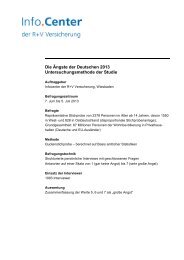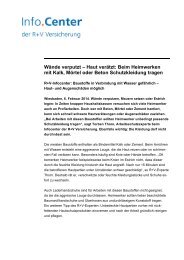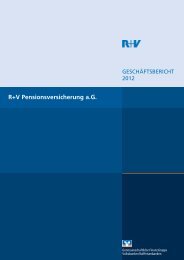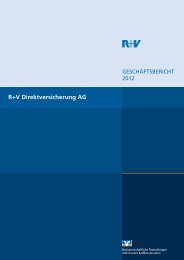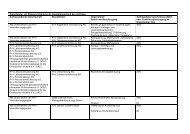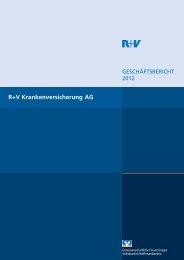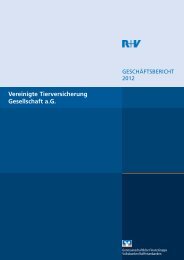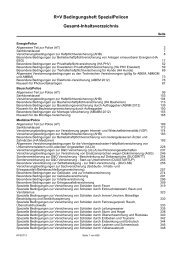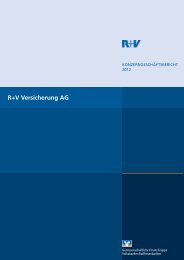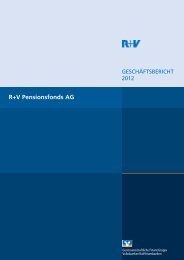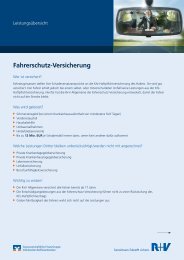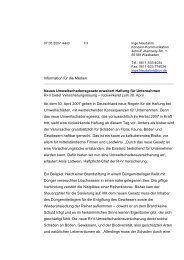R+V Versicherung AG Annual Report
R+V Versicherung AG Annual Report
R+V Versicherung AG Annual Report
You also want an ePaper? Increase the reach of your titles
YUMPU automatically turns print PDFs into web optimized ePapers that Google loves.
As a result of the relatively poor capitalization<br />
of many direct insurers and Latin<br />
America’s high frequency of natural disasters,<br />
the fire insurance class together<br />
with its supplementary elemental risks are<br />
heavily reinsured. After a phase of immense<br />
pressure on reinsurance conditions and<br />
correspondingly poor results, claim events<br />
initiated a market turnaround. The high<br />
costs incurred in the previous year by the<br />
storms “Mitch” and “Georges”, as well as<br />
flooding in Venezuela and the earthquake<br />
in Columbia, led to an increase in original<br />
premiums and paved the way for improved<br />
reinsurance conditions. The growth of these<br />
markets was severely restricted by the economic<br />
recession, however.<br />
Asia<br />
Southeast Asia started to experience an<br />
economic downturn in mid-2000 which<br />
snowballed during 2001. Real gross domestic<br />
product even fell at times in many countries.<br />
Only in China did overall economic<br />
production continue to expand at more or<br />
less the same speed. Taking the official<br />
statistics as a yardstick, real GDP has now<br />
been increasing at between 7% and 8%<br />
per year for many years, regardless of the<br />
performance of the global economy. In the<br />
other countries, the weakness in the US,<br />
Japanese and EU economies became<br />
increasingly apparent, with the result that<br />
exports collapsed in numerous cases. The<br />
setback in the IT sector had an even more<br />
critical impact, however. Many countries<br />
had specialized very heavily in such<br />
products, and for years their exports had<br />
benefited from the global boom; by the end,<br />
IT products had made up around a quarter<br />
of their total goods exports on average.<br />
11<br />
Consequently, the region – and especially<br />
Singapore, Malaysia and Taiwan – was<br />
extremely hard hit by the downturn in the<br />
market. In other countries which had not<br />
concentrated quite so heavily on IT products,<br />
such as South Korea and Thailand,<br />
vigorous expansion in domestic demand<br />
helped offset the weak exports.<br />
While exports fell much more sharply than<br />
imports throughout practically the whole<br />
region, the majority of Southeast Asian<br />
countries still recorded a sizeable balance<br />
of payments surplus. This reduced the<br />
risk that external economic shocks would<br />
trigger a crisis as in 1998. Another point in<br />
their favor was that inflation was low in all<br />
countries except Indonesia, which meant<br />
that the central banks were able to react to<br />
the economic downturn by relaxing their<br />
monetary policy.<br />
Like the Japanese economy as a whole,<br />
the Japanese insurance sector experienced<br />
difficulties. Life insurers were faced with<br />
major challenges due to the strained situation<br />
on the capital markets. Property and<br />
casualty insurers were forced to adapt to<br />
the consequences of deregulation.<br />
After the direct insurance market in Taiwan<br />
had developed extremely satisfactorily in<br />
2000, the fiscal year under review was<br />
characterized by stiff competition. This led<br />
to declining original rates in key insurance<br />
classes.<br />
China joined the World Trade Organization<br />
(WTO) and issued clear guidelines for<br />
regulatory approval of foreign insurance<br />
companies.



